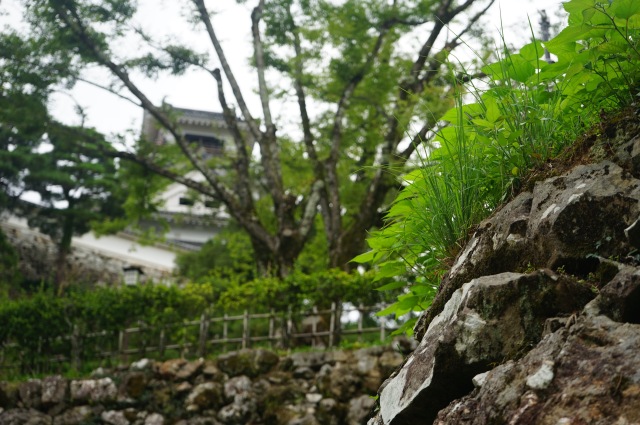
You might be shocked to hear that castles in Japan aren’t like the ones in Europe.
What? Say it ain’t so!
They were constructed with a different purpose than the stone ones in Ireland and Scotland that kept the Vikings out. Earthquakes are a big threat to most structures in Japan, and throughout history have regularly knocked them down.
This is why the walls bow inward to distribute the weight when the ground shakes, and to make it harder for the enemy to climb.

Climb this. I dare you. Seems easy enough? Do it with enemies firing arrows down at you and dropping rocks on your head.
Wood was chosen as the safer material, but wood has problems of its own. What if the enemy say, lights their arrows on fire and makes a campfire of your castle?

Saaay, that’s a nice castle. It’d be a shame if it were to catch fire.
The Japanese had a solution for this as well. Put your castle so high up the arrows of the time period can’t reach it. If the hill isn’t high enough, then mount the sucker on one really really high stone wall.

Set that on fire, mofos. Oh, and our archers will be shooting back, so be careful if you get too close. Be a shame if we were to turn your archers into pincushions.

Putting the castle up high also gives the advantage of seeing your attackers coming from very far away. You all look like ants down there.
Needless to say, my husband and I went to three very different castles over the summer vacation. Their names are Matsue, Matsuyama, and Kochi.
This was Matsue:

We went to Matsuyama at night and saw it light up:

Lastly, we visited Kochi Castle:

All three were heavily rebuilt, especially Matsue which was was set ablaze once in its history and had to be completely reconstructed.

The wood in Japanese Castles is beautiful and really slides under your feet. The beams used in castles crack in the middle as they age, but that’s a good thing. The split makes the beam stronger and more sturdier.
Motsu and Hiba wood is most commonly used in the construction of castles, temples, and shrines because it is fire-resistant and very strong. It is also treated to give it that slick feel.

They make you take off your shoes when you enter to protect the wood and because your shoes track in dirt. That sign means “Shoe Box”. Below it talks about removing your shoes before you enter.
If shoe boxes aren’t provided, then plastic bags usually are and you carry your shoes around.
For me, visits to Japanese castles take less than an hour. They aren’t like the ones in Europe. A lot of the floors look the same. The display cases sometimes have really interesting items and tidbits of history, but it is all kind of delivered in a dry manner.
The goal is to get to the top, take your pics, and get down without falling off the steep staircase.
When I took my family to Japan, I took them to one of the best: Himeji Castle. I’ve been to Himeji over three times and it’s one of the most extensive and unique. It’s also one of the original castles. (Kumamoto is another original, but the big earthquake over a year ago did huge damage that Kumamoto somehow miraculously survived).
The things I love most about Japanese castle is the wooden floors. It’s so softy and smooth. I could walk all day on those floors. They’re also super pretty from the outside. The inside however is like a dark cave.
How did people live in these?


Guess there must had been apartments where the samurai lords would have amenities prepared for a normal life!
LikeLiked by 1 person
We went through those. They’re not much different in most of the castles. It was futon on tatami. ‘Cept the servants put it out for you.
LikeLiked by 1 person
That would still be a nice thing. Wish we had someone make the beds for us too…
LikeLiked by 1 person
That would be so nice. 🙂
LikeLiked by 1 person
Very interesting.
LikeLiked by 1 person
Beautiful photos of Japanese castles. I really want to visit Himeji some day.
LikeLiked by 1 person
Himeji and Kumamoto are the best in my opinion. Definitely worth it. 🙂
LikeLiked by 1 person
Very interesting, and it gives me travel ideas! 🙂
LikeLiked by 1 person
Now you can get your castle on 🙂
LikeLiked by 1 person
So magical and beautiful!!
LikeLiked by 1 person